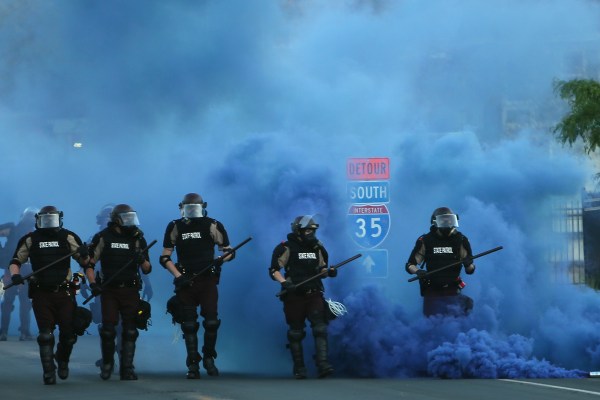The killing of George Floyd and the nationwide protests that resulted have been a major wake-up call for many with regards to the role of policing in the United States. Yesterday, Floyd’s hometown of Minneapolis announced plans to dismantle the city’s police department via a veto-proof majority in the city council.
Among the factors that have left segments of the population increasingly wary about police activity is a seemingly constant stream of images showing a military-style presence in cities across the U.S. MRAPs have become a mainstay in cities like Minneapolis and Seattle during protests.
The Mine-Resistant Ambush-Protected vehicles are lightweight tactical vehicles built to take an IED attack. Designed for the Iraq War, the vehicles resemble armored Humvees, creating quite the memorable image as they cruise down American streets in tandem, ahead of police clashes with protestors.
The MRAPs are just one in a long list of military hand-me-downs that have come into police possession courtesy of the 1033 program. Instituted as part of the 1997 National Defense Authorization Act passed under the Clinton administration (it’s listed as Section 1033 of that act), the program has been a key driver in getting tactical military equipment into the hands of civil law enforcement agencies.
It’s been a wildly successful program from that vantage point, ranging from big cities to small towns. In his 2013 book, “Rise of the Warrior Cop: The Militarization of America’s Police Forces,” Radley Balko says the program was responsible for 3.4 million orders delivered to 11,000 agencies across all 50 states. A year after the publication of Balko’s book, the program would come under increased national scrutiny, as Ferguson, Mo. entered the national spotlight following the shooting of Michael Brown Jr. by police officer Darren Wilson.
“With all that military gear, plus the federal drug policing grants and asset forfeiture proceeds, just about anyone running a police department who wanted a SWAT team could now afford to start and fund one,” writes Balko. “And so the trend crept into smaller and smaller towns. By the mid-2000s, SWAT had come to Middleburg, Pennsylvania (population: 1,363); Leesburg, Florida (17,000); Mt. Orab, Ohio (2,701); Neenah, Wisconsin (24,507); Harwich, Massachusetts (11,000); and Butler, Missouri (4,201), among others.”
A few months prior, the ACLU produced a massive report on police militarization entitled, “War Comes Home.” Based on public records requests from law enforcement agencies in 26 states and Washington. D.C., 1033 takes a central role in the study. In Arizona alone, the ACLU found a law enforcement cache that included, among others, 32 bomb suits, 1,034 guns, 120 utility trucks, 64 armored vehicles and 17 helicopters.
Since the late-90s, the program has transferred into the hands of civilian law enforcement some $7.4 billion in weapons and other Pentagon equipment. The program has, understandably, come under scrutiny from politicians. In a June 3 letter to minority leader Chuck Schumer, written amid the protests, Senator Bernie Sanders called for a prohibition on “the transfer of offensive military equipment to police departments.”
In fact, criticism of the program has been a bipartisan affair. In a 2014 op-ed, Kentucky Senator Rand Paul wrote, “When you couple this militarization of law enforcement with an erosion of civil liberties […] we begin to have a very serious problem on our hands.”
Today, House Democrats introduced legislation aimed at increasing transparency into police misconduct. The New York State legislature separately announced its own bills. While neither go as far as Minneapolis, it’s clear that many are interested in make sweeping changes to policing in the U.S. Given the longstanding scrutiny of the nearly quarter-century-old 1033, it seems the program is an ideal target for some of those changes.
